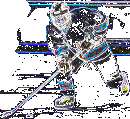Clearly the very first thing you should acquire by way of equipment is a pair of ice skates.
I made my first strides on the ice using rentals and hand-me-down ice skates, but my ice skating didn't reach the next level until I got myself a pair of ice skates that properly fit me. This in fact, would be my most ardent piece of advice: buy the best pair of ice skates you can afford. Your ice skates should be the most expensive pair of footwear you own. Of course, you might own a lovely pair of Bruno Maglis, in which case, spending $300 on a pair of ice skates won't be unusual, but when I was bought my first (and only) pair I gawked with sticker shock.
Before we break open the credit cards, let me suggest, if you haven't bought skates yet, to closely observe the hockey skates that people are wearing today. You might be able to do this watching a game on TV, but the best way to get a feel for the brands that are out there is to look at the boots skaters are wearing at your local public ice skating session. Buy a hockey magazine and look at the pictures and advertisements. Use the Internet, and read reviews.
When I started playing in the mid-1990s, the two major brands were CCM and Bauer. In the end, I liked the "look" of the Bauer skate more. This isn't necessarily a bad criteria: skates should look good to your eye. When I got to my local sporting goods store (I'm lucky that I live near a great ice hockey store, Sports Etc.), I was all set to buy Bauers. However, the salesperson guided me to a similar model that made sense (and still looked good): Riedells. Mine had a sleek 491 stamped on the side, and I still enjoy its look today. (Alas, the Riedell ice hockey skate is no longer being made, as far as I can tell.)
I spent almost $250 on my skates, and as I said earlier, I had some sticker shock, but $250 is a reasonable investment considering that a good boot protects you (number one) and shapes itself to your feet (number two) better than a cheaper pair would.
As a final piece of guidance: give your new boots some time before they properly break in. I felt like it took my pair of skates almost a month before they felt "less stiff." Anyone playing regularly will be able to break theirs in sooner, but I bought my pair and only did public ice skating for months before I hit a regular playing schedule.
And finally (finally!), keep your blades sharpened. My friend Paul kept a tool to keep his edges sharp in between getting his skates sharpened at the shop. He introduced me to the concept of "skate profiling", and as you improve you may want to talk to your skate sharpener about adjusting your radius.
